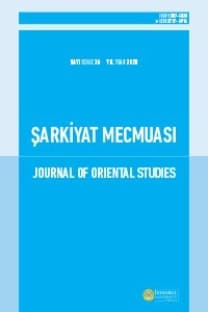Hisae Sawachi’nin 14 Sai: Fōteen Romanında Militarizm Algısı ve Gyokusai Kavramı
Hisae Sawachi, 14 Sai, Militarizm, Gyokusai, Savaş, Onurlu intihar
Perceptions Toward Militarism and the Concept of Gyokusai in Hisae Sawachi’s Novel 14 Sai
Hisae Sawachi, 14 Sai, Militarism, Gyokusai, War, Honorable suicide,
___
- Akita, Kimiko ve Kenney, Rick. “Of kamikaze, sakura, and gyokusai: Misappropriation of Metaphor in War Propaganda”. Japanese Studies Review. XVIII (2014): 27-45.
- Atsushi, Awazuhara. “Perceptions of Ambiguous Reality: Life, Death and Beauty in Sakura”. Japanese Religions 32. (2007): 39 – 51.
- Buell R. L. “Militarism in Japan”. Current History (1916-1940). 15 (2) (1921): 205-213.
- Colegrove, Kenneth. “Militarism in Japan’s Foreign Policy”. The Annals of the American Academy of Political and Social Science 215. (1941): 7 – 16.
- Cook Taya, Haruko.“Turning Women into Weapons: Japan’s Women, the Battle of Saipan, and the “Nature of the Pacific War”. Women and War in the Twentieth Century. Haz. Nicole Ann. Dombrowski içinde 178 – 194. New York ve London: Routledge, 2005.
- Di Marco, Francesca. “Act or Disease? The Making of Modern Suicide in Early Twentieth-century Japan”. The Journal of Japanese Studies 39. 2 (2013): 325-358.
- Eguchi, Keiichi. “Teikoku Nihon no Tō - Ajia Shihai”, Manchukuo Kindai Nihon to Shokuminchi: Shokuminchi Teikoku Nihon (1) (近代日本と植民 地:植民地帝国日本). Haz. Shinobu Ōe, içinde, Tokyo: Iwanami Shoten, 2001.
- Gomi, Fumihiko. Toshihiko Takano ve Yasushi Toriumi. Shōsetsu Nihon-shi Kenkyū(詳説日本史研究), Tokyo: Yamakawa Shuppansha, 2000.
- He, Yinan. “National Mythmaking and the Problems of History in Sino – Japanese Relations”. Japanese Relations with China: Facing Arising Power. haz. Peng Lam Er. içinde 69 – 91. Londra ve New York: Routledge, 2006.
- Hoyt, Edwin P. Japonya: Asker Bir Ulusun İntiharı. çev. Şerif Erol. İstanbul: Sabah Kitapları, 1995.
- Inoguchi, Rikihei, Tadashi Nakajima ve Roger Pineau. Japan’s Kamikaze Force in World War II. Wisconsin: Bluejacket Books, 1958.
- Inuzuka, Takaaki. Mori Arinori (森有礼). Tokyo: Yoshikawa Kōbunkan. 1985.
- Kantorowicz, Ernst H. “Pro Patria Mori in Medieval Political Thought. American Historical Review. 56 (3) (2006): 472 – 492.
- Küçükyalçın, Erdal. Samuraylar Çağı. İstanbul: İnkılâp Kitabevi, 2013.
- Levent, Sinan. İkinci Dünya Savaşı Yolunda Japonya: Cumhuriyet Gazetesi Üzerinden Türk Basınında Japonya İmajı (1933 – 1941). İstanbul: Kitapdostu Yayınları, 2015.
- Ohnuki-Tierney, Emiko. Kamikaze, Cherry Blossoms and Nationalisms: Militarization of Aesthetics in Japanese History. Chicago ve London: University of Chicago Press, 2002.
- Owada, Tetsuo. Nihon no Rekishi 101 no nazo (日本の歴史101の謎). Tokyo: Mikasa Shobō, 2003. Sawachi, Hisae. 14歳(フォーティーン):満洲開拓村からの帰. Tokyo: Shūeisha. 2015.
- Seraphim, Franziska. War Memory and Social Politics in Japan 1945–2005. Massachusetts & London: Harvard University Press, 2006.
- Shaftall, Mordegai George. “An Genealogy of Imperial Era Japanese Militarism”. The Origins of Second World War: An International Perspective. Haz. Frank Mcdonough. içinde 50 – 65. London ve New York: Continuum International Publishing Group, 2011.
- Shibata, Ria. “Memories of the War and Japanese “Historical Amnesia”. Education and Society. 35 (1) (2017): 5 – 25.
- Shogimen, Takashi. “Another” Patriotism in Early Shōwa Japan (1930-1945)”. Journal of the History of Ideas. 71/1 (2010): 139- 160.
- Takahashi, Saburo. Senkimono wo Yomu (戦記物を読む). Tokyo: Academia Press, 1988.
- Wang, Xuanjing. “The Voices of Women: The Literature of Manchurian Repatriation”. Osaka University Knowledge Archive. 4 (2021): 69 – 82.
- Yıldız, Özgür. “İkinci Dünya Savaşına Genel Bir Bakış”. Journal of International Management and Social Researches. 6/12 (2019): 53-75.
- “九条の会「時勢はどんどん悪くなる」会見で澤地久枝さん” Erişim 09 Ocak 2019, https://mainichi.jp/ articles/20180915/koo/oom/040/020000c.
- Soemu Toyoda Tribunal Transcripts - USU Digital Collections Erişim 22 Aralık 2021, https:// digital.lib.usu. edu/digital/collection/p16944coll30.
- 授業づくりJAPAN YOKOHAMAプライマリー (fc2.com) Erişim 15 Ağustos 2022, mutukawa34413. blog.fc2.com/img/2015121621394735a.jpg/
- ISSN: 1307-5020
- Yayın Aralığı: 2
- Başlangıç: 1956
- Yayıncı: İstanbul Üniversitesi Edebiyat Fakültesi Şarkiyat Araştırma Merkezi
Tasavvufî Düşüncede Akıl ve Attâr’ın Rubâîlerinde Akıl Mefhumu
Harranlı Şair Yusuf b. Fazlullâh es-Sekâkînî’nin Hayatı, Edebî Kişiliği ve Züht Anlayışı
İlk Evrelerinden Cahiliye Dönemine Kadar Arap Dili
Abdelkarim AMIN MOHAMED SOLIMAN, Senem CEYLAN
Bizans İmparatorluğu ve İslâm Hilâfeti Arasında Paylaşılamayan Ada: Kıbrıs (28-353/648-965)
Cibrân Halil Cibrân’da Devrimci Eğilim: Betimleyici ve Analitik Bir Çalışma
Hüseyin ESVED, Mahmoud BAKDASH1
Şair, Feylesûf ve Şüphe: Ömer Hayyâm Rubailerinde İbn-i Sînâcı Düşünceye Gönderme ve Eleştiriler
Tayyib Sâlih’in Kuzeye Göç Mevsimi Adlı Romanında Şehrin Fezası
Dante ve Orta Çağ’da Dinî Sembolizm
Osmanlı İmparatorluğu ve Hint Müslümanları İlişkilerinde Hilafet Hareketinin Rolü
